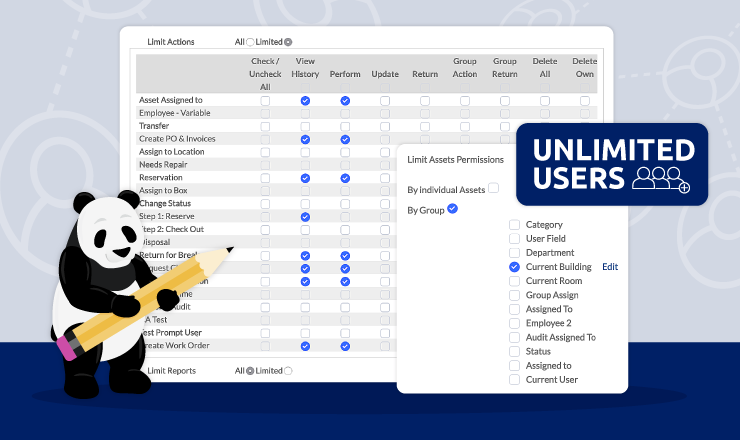ISO 14001 Certification – Compliance with Asset Panda

Take Control of Your Assets
A personalized demo is just one click away.
For businesses of all sizes and industries, sustainability has become an increasingly important consideration. Whether your organization is required to adhere with certain environmental regulations, or you’re simply committed to decreasing your carbon footprint, an environmental management system (EMS) can help you achieve these goals.
An environmental management system hosts a set of processes that allow your organization to track environmental impacts and increase sustainability. In order for organizations to build an effective EMS that demonstrates regulatory compliance and environmental responsibility, it’s vital to follow the correct framework, such as the ISO 14001 standard.
In this guide, we’ll review what ISO 14001 is, what the certification process entails, and how asset management software can help you attain ISO 14001 compliance.
What is the ISO 14001 Certification?
ISO 14001 is the international standard for environmental management systems. The standard provides a clear framework for organizations to build and maintain an EMS and, in turn, obtain ISO 14001 certification. Organizations that adhere to the framework and achieve certification demonstrate their commitment to continually improving their environmental performance. More than 500,000 organizations across 180 countries have achieved the ISO 14001 certification.
The ISO 14001 standard was first published in 1996, with the third and most recent edition being released in 2015. Some key areas of change in the ISO 14001:2015 framework include:
- Greater involvement from leadership
- Increased alignment with overall company strategy
- More effective communications strategy
- Increased focus on proactive initiatives and optimizing environmental performance
- Greater consideration for lifecycle management
The Benefits of ISO 14001 Certification
As an internationally recognized standard, there are various advantages to achieving ISO 14001 compliance. Three key benefits of certification include:
- Improved operational efficiency and cost savings: By continually improving environmental performance, your organization will realize huge resource efficiencies and, in turn, save on operating costs.
- Increased regulatory compliance: With ISO 14001 compliance, you can clearly demonstrate your organization’s environmental performance for applicable laws and regulations. Plus, maintaining an EMS with clear historical records can streamline other compliance audits.
- Enhanced reputation and competitive edge: Demonstrating your commitment to the environment can improve your business’s reputation and help you win more business, particularly from customers who value or require certain environmental performance from their vendors.
ISO 14001 Requirements
While the ISO 14001 standard provides a clear framework for environmental management systems, there are numerous steps to follow to effectively build your EMS and achieve ISO 14001 compliance.
1. Research
Before you begin building your environmental management system, it’s essential to first understand what all the ISO 14001 framework entails. Organizations that are ready to start setting up their EMS and working towards certification can start the process by purchasing a copy of the ISO 14001 standard
2. Environmental Gap Analysis
Once you have a clear understanding of how you can build an ISO 14001-compliant EMS, you should next evaluate where your organization currently stands in terms of environmental performance. When performing your environmental gap analysis, it’s important to review how your current business operations are managed, applicable environmental regulations and how you adhere to them, and any previous or ongoing environmental issues. Having a clear picture of where your business stands will help you determine which areas to prioritize first upon implementing your EMS.
3. Planning
After determining key focus areas from your environmental gap analysis, you should set clear objectives for these areas to measure their performance moving forward. In this stage, you should also select a dedicated EMS team that will build the system and help promote user adoption across the organization.
Further, this stage is where you’ll finalize where your EMS will be hosted. Whether you build an in-house system or purchase customizable software like an asset management platform, ensure you have the appropriate buy-in from leadership and get your core design team up to speed on any third-party software.
4. System Design and Implementation
Next, it’s time to put your plans into action and design your EMS. This part of the process will include customizing your platform to match the specific fields, categories, and workflows your team will need to manage company assets and track environmental performance. Your dedicated EMS team must effectively document how the system works and what your varying processes entail to help with future training and compliance.
Once your EMS is live, it’s essential to add your team members to your system and assign the appropriate user access to each person. From there, ensure all your EMS users are properly trained on your system before they officially begin using it.
5. Internal Audits
After your team has been actively using the EMS for at least a few months, start conducting internal audits to measure your progress. These internal audits should both evaluate your environmental performance against the objectives set in the planning phase and confirm that your team members are following processes correctly. Internal audits are an excellent tool to correct any areas of non-compliance or lagging objectives and, of course, prepare for the external certification audit.
6. Certification Audit
Once you feel your internal audit results are in a good place, you’re ready to pursue the formal certification audit. The ISO 14001 certification audit must be performed by an external body to ensure objectivity. To find the right certification body, the ISO recommends:
a. Evaluating several options,
b. Confirming if the body adheres to the relevant CASCO standard, and
c. Selecting an accredited certification body.
Once you’ve passed your initial certification audit, your third-party certification body should perform surveillance audits each year and an official re-certification audit every three years. It’s important to note that the ISO 14001 standard typically undergoes revisions every 5-10 years, so an updated standard may require sooner re-certification.
6 Benefits of Using an Asset Management Platform for Your EMS
When it comes to building an effective environmental management system, selecting highly configurable software to house your data and procedures is often the best route. Here are 6 key benefits to building your EMS in a customizable asset management platform.
1. Full Asset Lifecycle Tracking
From IT devices to industrial equipment and beyond, a robust asset management platform can track the full lifecycle history of your assets. With clear insight into an item’s repair and assignment history, current depreciated value, and asset utilization, you can better maintain your assets and lengthen their lifespans. Asset lifecycle management not only helps you sustainably utilize your assets but also determine when it makes sense to replace them for productivity and energy efficiency purposes.
2. Clear Audit Trails
Beyond helping you sustainably manage your devices and equipment, detailed asset management records help you provide clear audit trails for ISO 14001 certification. Even for retired assets, you can archive their records so that they’re still accessible for auditing purposes. With the full history of your physical assets and completed EMS processes available in one centralized place, an asset management platform makes it easy for external auditors to review your compliance.
3. Comprehensive User Management
Certain asset management software allows for unlimited users and fully customizable roles, which means you can grant the right access to the right people. By ensuring that only authorized users can edit records or perform certain workflows, you'll uphold your procedures and enhance ISO 14001 compliance. With your entire team in your environmental management system, you can easily assign tasks to available employees and keep everything on track.
4. Standardized Workflows
The right asset management platform should allow you to create custom, standardized workflows to ensure procedures adhere to the ISO 14001 framework. Beyond ensuring that your processes follow a certain sequence of events, you can also add required fields like date and time stamps, signatures, and more. Plus, you can easily see who completed what workflow to enhance accountability and easily address any non-compliance issues.
5. Real-time Alerts
Even with your standardized processes, compliance issues may arise from time to time. To help you stay ahead of any potential red flags—whether it be an incomplete workflow or an inefficient asset or facility—look for a solution that allows you to set custom alerts that automatically notify you when the issue occurs. Being aware of non-compliance in real time allows you to resolve issues quickly and avoid impacting your long-term environmental performance.
6. Data Integrity
With so many valuable assets and procedures stored in your EMS, you need to be confident that your data is secure. When selecting asset management software, look for providers that offer high data encryption levels and have relevant certifications like SOC 2 or ISO 27001. To further unify and secure your tech stack, consider an asset management solution that integrates with the other software applications you rely on.
How Asset Panda Can Help You Receive the ISO 14001 Certification
Building an environmental management system and receiving ISO 14001 certification is a long and complex process. With robust asset management software like Asset Panda, creating an effective and compliant EMS is achievable.
Asset Panda’s highly flexible solution can be customized to match your unique naming conventions, assets, and processes for seamless user adoption. With our full asset lifecycle tracking and robust records, you’ll have the audit trails you need to demonstrate improved environmental performance and ultimately achieve ISO 14001 compliance.
Ready to see how Asset Panda can make your EMS goals a reality? Request your demo today to speak with a product expert.
Take Control of Your Assets
A personalized demo is just one click away.
Related News & Press

Learn more from an Asset Panda expert
Get a FREE consultation with an asset tracking expert to find out how you can transform your asset tracking.
Contact our Sales Team at (888) 928-6112


